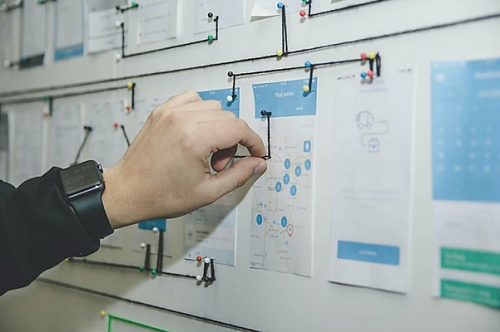Diana Barden, Director of Management Learning and Coaching, writes:
It’s a new project (or several): ‘What does the next phase look like for our businesses?’ and ‘How do we get our workforce into that next phase?’ If you and your colleagues are feeling daunted by this, you’re not alone.
Despite the great complexity of the requirements, the core principles for managing projects are simple. A project is a discrete, self-contained package of work with clearly defined goals, timescales, milestones, resources, budgets and a management team. Following project management processes will make your task manageable and the Top Ten Tips listed here can ensure successful, on-time, in-budget completion.
1. Think first, do second
If you don’t have even a semblance of a plan then you will have sown the seeds of failure before you even start. Always make the time and space to produce a plan. This is especially important in these times of greater uncertainty and greater pressure.
2. Why, what and how
Talk to the project sponsors and understand what they’re expecting. In this case you may need to speak to Board Members or the HR Director, or all of the above. Doing so will give you context and reference bases for decision making. Put some boundaries around what you are going to do or not do and agree with your sponsor(s) that this is just the starting point and then plan how you are going to achieve this.
3. Calculate the end deadline
There is always a sequence of events that happen in any project. Almost always there is more than one sequence happening at the same time. Work out which of the sequences takes the longest to give you your end deadline. Don’t forget to add some contingency and then present your logical findings to your sponsor for approval/agreement/ negotiation. The logic of your thinking should override wishful deadlines from your sponsor(s).
4. Plan your first steps in detail
The journey of a thousand miles begins with the first steps. Just because this is a cliché, it doesn’t mean it is untrue. So help your team start their journey by planning with them the first steps through to the visible horizon. The visible horizon is that point in time up to which you can predict with reasonable certainty that the project environment, goals etc, will not change. Be prepared that the visible horizon may much closer than usual, this is entirely appropriate during the pandemic.
5. Involve your staff/team members
In my past I was in charge of building a Type 42 destroyer and I involved our users, MOD sailors, in ensuring that what we were building was fit for purpose, every day. In this situation that will almost certainly be your managers and possibly your general staff. They’re the experts on how and when they’re going to use the ouputs, after all. Plan where and when the involvement will take place and agree the schedule with everyone –even if it is difficult!
6. Plan your communications
Many projects fail because communications are not planned and when thing go wrong, people start to blame each other. Identify who are the key people to the project across the spectrum of customers, users, sponsors, line managers, team members, influencers, finance, etc and plan and agree what and how you will communicate with them and how often.
7. Prioritise and plan your own time
Some things are critical to your project, like meeting your deadlines. So identify those tasks that have a direct impact on the end deadline. (Critical path analysis can do this for you). Then apportion your working day appropriately to tightly control these tasks and loosely control the others. Look for symptoms of success or failure and manage them.
8. Manage the risks
Identify the events that could have any negative consequence for your project, determine their probability of happening and the impact on your project if they do.
- if it is low risk then track the trends
- if it is middle risk then set aside some contingency of time and/or money
- if it is high risk then have plans made up and ready to counter the risk
9. Manage the project and not the tasks
Don’t get drawn into doing technical tasks. Good effective project managers plan, organise the activities, lead, motivate, communicate, monitor and then act on this information. They work with the natural chaos that can be the activity of a project, to guide and direct everyone and everything in order to meet the project goals that have been set and inevitably get modified.
10. Inspect, don't expect
If you inspect, things are more likely to get done - though this is easier said than done. Skilful inspection leaves team members motivated and encouraged to perform and not feeling put upon, hovered over or micro managed.
If you’re still feeling daunted, you’re still not alone. The COVID19 pandemic is almost certainly the biggest, single disrupting factor for businesses across the world right now and we’re all making difficult decisions on a daily basis. I know this because it’s true for my business too.
The tips above don’t make the job easy, but they do give you a clear way forward.
